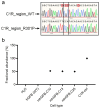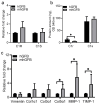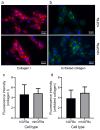Impact of a Heterozygous C1RR301P/WT Mutation on Collagen Metabolism and Inflammatory Response in Human Gingival Fibroblasts
- PMID: 40214433
- PMCID: PMC11987961
- DOI: 10.3390/cells14070479
Impact of a Heterozygous C1RR301P/WT Mutation on Collagen Metabolism and Inflammatory Response in Human Gingival Fibroblasts
Abstract
Periodontal Ehlers-Danlos syndrome arising from heterozygous pathogenic mutation in C1R and/or C1S genes is an autosomal-dominant disorder characterized by early-onset periodontitis. Due to the difficulties in obtaining and culturing the patient-derived gingival fibroblasts, we established a model system by introducing a heterozygous C1RR301P/WT mutation into human TERT-immortalized gingival fibroblasts (hGFBs) to investigate its specific effects on collagen metabolism and inflammatory responses. A heterozygous C1RR301P/WT mutation was introduced into hGFBs using engineered prime editing. The functional consequences of this mutation were assessed at cellular, molecular, and enzymatic levels using a variety of techniques, including cell growth analysis, collagen deposition quantification, immunocytochemistry, enzyme-linked immunosorbent assay, and quantitative real-time reverse transcription polymerase chain reaction. The C1RR301P/WT-mutated hGFBs (mhGFBs) exhibited normal morphology and growth rate compared to wild-type hGFBs. However, mhGFBs displayed upregulated procollagen α1(V), MMP-1, and IL-6 mRNA expression while simultaneously downregulating collagen deposition and C1r protein levels. A modest accumulation of unfolded collagens was observed in mhGFBs. The mhGFBs exhibited a heightened inflammatory response, with a more pronounced increase in MMP-1 and IL-6 mRNA expression compared to TNF-α/IL-1β-stimulated hGFBs. Unlike cytokine-stimulated hGFBs, cytokine-stimulated mhGFB did not increase C1R, C1S, procollagen α1(III), and procollagen α1(V) mRNA expression. Our results suggest that the C1RR301P/WT mutation specifically disrupts collagen metabolism and inflammatory pathways in hGFBs, highlighting the mutation's role in these processes. While other cellular functions appear largely unaffected, these findings underscore the potential of targeting collagen metabolism and inflammation for therapeutic interventions in pEDS.
Keywords: collagen metabolism; complement component 1r/1s (C1r/C1s); heterozygous C1RR301P/WT-mutated human TERT-immortalized gingival fibroblasts (mhGFBs); periodontal Ehlers–Danlos syndrome.
Conflict of interest statement
The authors declare no conflicts of interest.
Figures







Similar articles
-
Degradation of collagen I by activated C1s in periodontal Ehlers-Danlos Syndrome.Front Immunol. 2023 Mar 7;14:1157421. doi: 10.3389/fimmu.2023.1157421. eCollection 2023. Front Immunol. 2023. PMID: 36960056 Free PMC article.
-
C1R Mutations Trigger Constitutive Complement 1 Activation in Periodontal Ehlers-Danlos Syndrome.Front Immunol. 2019 Nov 5;10:2537. doi: 10.3389/fimmu.2019.02537. eCollection 2019. Front Immunol. 2019. PMID: 31749804 Free PMC article.
-
Effect of transforming growth factor-beta1, interleukin-6, and interferon-gamma on the expression of type I collagen, heat shock protein 47, matrix metalloproteinase (MMP)-1 and MMP-2 by fibroblasts from normal gingiva and hereditary gingival fibromatosis.J Periodontol. 2003 Mar;74(3):296-306. doi: 10.1902/jop.2003.74.3.296. J Periodontol. 2003. PMID: 12710748
-
Periodontal Ehlers-Danlos Syndrome Is Caused by Mutations in C1R and C1S, which Encode Subcomponents C1r and C1s of Complement.Am J Hum Genet. 2016 Nov 3;99(5):1005-1014. doi: 10.1016/j.ajhg.2016.08.019. Epub 2016 Oct 13. Am J Hum Genet. 2016. PMID: 27745832 Free PMC article.
-
A familial case of periodontal Ehlers-Danlos syndrome lacking skin extensibility and joint hypermobility with a missense mutation in C1R.J Dermatol. 2022 Jul;49(7):714-718. doi: 10.1111/1346-8138.16372. Epub 2022 Apr 1. J Dermatol. 2022. PMID: 35365885
References
-
- Kapferer-Seebacher I., Lundberg P., Malfait F., Zschocke J. Periodontal manifestations of Ehlers-Danlos syndromes: A systematic review. J. Clin. Periodontol. 2017;44:1088–1100. - PubMed
-
- Kapferer-Seebacher I., Oakley-Hannibal E., Lepperdinger U., Johnson D., Ghali N., Brady A.F., Sobey G., Zschocke J., van Dijk F.S. Prospective clinical investigations of children with periodontal Ehlers-Danlos syndrome identify generalized lack of attached gingiva as a pathognomonic feature. Genet. Med. 2021;23:316–322. doi: 10.1038/s41436-020-00985-y. - DOI - PubMed
-
- Kapferer-Seebacher I., van Dijk F.S., Zschocke J. Periodontal Ehlers-Danlos Syndrome Synonyms: EDS Type VIII, pEDS. In: Adam M.P., Feldman J., Mirzaa G.M., Pagon R.A., Wallace S.E., Bean L.J.H., Gripp K.W., Amemiya A., editors. GeneReviews [Internet] University of Washington; Seattle, WA, USA: 2021. pp. 1993–2025.
Publication types
MeSH terms
Substances
Grants and funding
LinkOut - more resources
Full Text Sources
Miscellaneous

